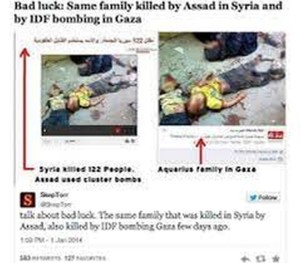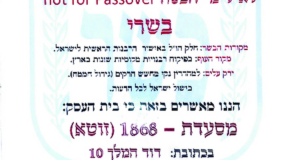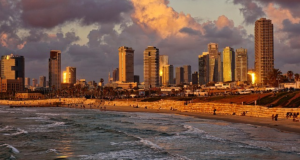Such repurposing of images has occurred in previous rounds of Hamas-Israel warfare.
 Gaza City, February 18 – While the militant Islamist organization that runs this coastal territory has not engaged in large-scale hostilities with Israel since the summer of 2014, it remains busy repairing its tunnels, replenishing its arsenal of rockets, and building up its inventory of images of the carnage in Syria to be relabeled as Gaza in case open conflict erupts again.
Gaza City, February 18 – While the militant Islamist organization that runs this coastal territory has not engaged in large-scale hostilities with Israel since the summer of 2014, it remains busy repairing its tunnels, replenishing its arsenal of rockets, and building up its inventory of images of the carnage in Syria to be relabeled as Gaza in case open conflict erupts again.
Hamas’s cyber division has recruited or drafted hundreds of people to sift through video clips, photographs, and other files coming from the five-year-old Syrian Civil War and other hotbeds of unrest around the world to find especially heartbreaking or brutal specimens. That bank of images and clips will then undergo individual recaptioning to remove each one’s Syrian, Libyan, Iraqi, Yemeni, or other pedigree to be reattributed to Israeli strikes on Gaza over the course of the next war.
Such repurposing of images has occurred in previous rounds of Hamas-Israel warfare, whether in 2014 or the two previous iterations in 2012 and 2009. It augments the efforts of Hamas and its allies elsewhere to doctor images for the same purpose. Experts note that the conduct of the image-gathering in an organized, prepared fashion represents a significant enhancement in the organization’s combat readiness.
“Hezbollah and Hamas have long relied on doctoring or staging poignant images, or ones that showcase the enemy’s brutality against the backdrop of its own population’s childhood innocence,” explained analyst Foat O’Shop. “And of course as the conflict rages, partisans of those groups look for whatever images they can to slander Israel, regardless of the actual image source. We saw that again and again, with the ruins of a mosque in West Africa labeled as the aftermath of an Israeli strike. What makes the new development different is the level of preparation that goes into that effort. The next Hamas salvo in the arena of public opinion is going to be much more than some ad hoc effort.”
Victims of the Syrian conflict, in which 470,000 people have lost their lives and millions more have been displaced, voiced mixed emotions at the prospect of Hamas once again co-opting their suffering for its own political ends. “Assad, ISIS, Hezbollah, and Russia are starving and massacring us with impunity, and no one actually cares,” said Aymnatta Falestinian. “But if Hamas uses the documentation of our suffering, in some small measure the pictures of our brutalization at the hands of those monsters will be used to spur someone to action, even if that action will accomplish nothing to relieve our misery.”
She said she was monitoring news reports for indications that human rights advocates were organizing demonstrations, boycotts, or petitions to protest Russia’s operations in Syria, so far without finding anything. “It’s possible those images have already been relabeled, so nobody realizes they’re not from Gaza, and they don’t know the right target for opprobrium,” she surmised.



